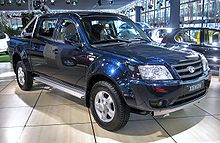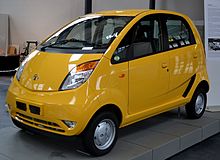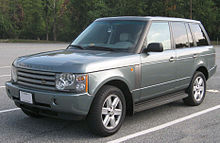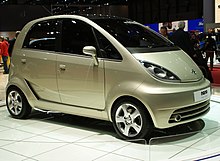| Type | Public company |
|---|---|
| Traded as | NSE: TATAMOTORS BSE: 500570 NYSE: TTM BSE SENSEX Constituent |
| Industry | Automotive |
| Founded | 1945 |
| Founder(s) | Jamshed Ji Tata |
| Headquarters | Mumbai, Maharashtra, India[1] |
| Area served | Worldwide |
| Key people | P. M. Telang, (MD) C. Ramakrishnan, (CFO) |
| Products | Automobiles Commercial vehicles Automotive parts |
| Services | Vehicle leasing Vehicle service |
| Revenue | |
| Profit | |
| Total assets | |
| Total equity | |
| Employees | 53,151 (2011)[2] |
| Parent | Tata Group |
| Subsidiaries | Jaguar Land Rover TDCV Tata Hispano |
| Website | www.tatamotors.com |
Tata Motors is South Asia’s largest automobile company; it is the leader in commercial vehicles and among the top three in passenger vehicles. Worldwide it is the world's fourth-largest truck manufacturer and second-largest bus manufacturer.[2] It has auto manufacturing and assembly plants in Jamshedpur, Pantnagar, Lucknow, Sanand, Dharwad and Pune, India, as well as in Argentina, South Africa, Thailand and the United Kingdom. Tata Motors has produced and sold over 6.5 million vehicles in India since 1954.[4]
Originally a manufacturer of locomotives, the company manufactured its first commercial vehicle in 1954 in a collaboration with Daimler-Benz AG, which ended in 1969.[5] In 2010, Tata Motors surpassed Reliance to win the coveted title of 'India's most valuable brand' in an annual survey conducted by Brand Finance and The Economic Times.[6]. Tata Motors was ranked as India's 3rd Most Reputed Car manufacturer [7] in the Reputation Benchmark Study - Auto (Cars) Sector, launched in April 2012.
Tata Motors is a cross-listed company; its stock trades on the Bombay Stock Exchange and the New YoHistory
Tata Motors is a part of the Tata Group manages its share-holding through Tata Sons. The company expanded its operations to commercial vehicle sector in 1954 after forming a joint venture with Daimler-Benz AG of Germany. Despite the success of its commercial vehicles, Tata realized his company had to diversify and he began to look at other products. Based on consumer demand, he decided that building a small car would be the most practical new venture. So in 1998 it launched Tata Indica, India's first fully indigenous passenger car. Designed to be inexpensive and simple to build and maintain, the Indica became a hit in the Indian market. It was also exported to Europe, especially the UK. Tata acquired Spanish bus and coach manufacturer Hispano Carrocera in 2009.[8] In 2006 it formed a joint venture with Marcopolo S.A. of Brazil, and introduced low-floor buses in the Indian Market under the name Tata Marcopolo Bus. Recently, it has acquired British Jaguar Land Rover (JLR), which includes the Daimler and Lanchester brand names.
[
edit] Acquisitions
- In 2004 Tata Motors acquired Daewoo's truck manufacturing unit, now known as
- Tata Daewoo Commercial Vehicle, in South Korea.[9]
- In 2005, Tata Motors acquired 21% of
- Aragonese Hispano Carrocera giving it controlling rights of the company.
- In 2007, Formed a joint venture with
- Marcopolo of Brazil and introduced low-floor buses in the Indian Market.[10]
- In 2008, Tata Motors acquired British
- Jaguar Land Rover (JLR), which includes the Daimler and Lanchester brand names.[11][12][13][14]
- In 2010, Tata Motors acquired 80% stake in Italy-based design and engineering company Trilix for a consideration of €1.85 million. The acquisition is in line with the company’s objective to enhance its styling/design capabilities to global standards.
- [15]
[
edit] Expansion

The 2nd generation Tata Indica V2's fuel economy, powerful engine and aggressive marketing strategy made it one of the best selling cars in the history of the Indian automobile industry.
[
edit] Vehicles
[
edit] Tata Daewoo Commercial Vehicle
Main article:
Tata Motors aimed to increase its presence worldwide. In 2004, it acquired the Daewoo Commercial Vehicle Company of South Korea. The reasons behind the acquisition were:- Company's global plans to reduce domestic exposure. The domestic commercial vehicle market is highly cyclical in nature and prone to fluctuations in the domestic economy. Tata Motors has a high domestic exposure of ~94% in the MHCV segment and ~84% in the light commercial vehicle (LCV) segment. Since the domestic commercial vehicle sales of the company are at the mercy of the structural economic factors, it is increasingly looking at the international markets. The company plans to diversify into various markets across the world in both MHCV as well as LCV segments.
- To expand the product portfolio Tata Motors recently introduced the 25MT GVW Tata Novus from Daewoo’s (South Korea) (TDCV) platform. Tata plans to leverage on the strong presence of TDCV in the heavy-tonnage range and introduce products in India at an appropriate time. This was mainly to cater to the international market and also to cater to the domestic market where a major improvement in the Road infrastructure was done through the
[
edit] Hispano Carrocera
Main article:
In 2005, sensing an opportunity in the fully built bus segment, Tata Motors acquired a 21% stake in Hispano Carrocera SA,[17] the leading European bus and coach cabin maker. In 2009, the company picked up the remaining 79% stake in Hispano Carrocera SA for an undisclosed sum, making it a fully owned subsidiary.[
edit] Jaguar Cars and Land Rover
Main articles:
After the acquisition of the British Jaguar Land Rover (JLR) business, which also includes the Daimler, Lanchester and Rover brands,[18] Tata Motors became a major player in the international automobile market. On 27 March 2008, Tata Motors reached an agreement with Ford to purchase their Jaguar Land Rover operations for US$2.3 billion. The sale was completed on 2 June 2008.[14]In addition to the brands, Tata Motors has also gained access to two design centres and two plants in UK. The key acquisition would be of the intellectual property rights related to the technologies.
[
edit] Joint ventures

Tata Motors also formed a joint venture with Fiat and gained access to Fiat’s diesel engine technology.[19] Tata Motors sells Fiat cars in India through a 50/50 joint venture Fiat Automobiles India Limited, and is looking to extend its relationship with Fiat and Iveco to other segments. Tata has also formed several JV's with many small companies in various countries around the world.
[
edit] Important developments
[
edit] Tata Nano
Main article:
In January 2008, Tata Motors launched Tata Nano, the least expensive production car in the world at about
Tata has faced controversy over developing the Nano as some environmentalists are concerned that the launch of such a low-priced car could lead to mass motorization in India with adverse effects on pollution and global warming. Tata had set up a factory in Sanand, Gujarat and the first Nanos were rolled out in summer 2009.
Tata Nano Europa had been developed for sale in developed economies and it hit markets in 2010 while the normal Nano had hit markets in South Africa, Kenya and countries in Asia and Africa by late 2009. A battery version is also planned.
[
edit] Tata Ace
Main article:
Tata Ace, India's first indigenously developed sub-one ton mini-truck, was launched in May 2005. The mini-truck was a huge success in India with auto-analysts claiming that Ace had changed the dynamics of the light commercial vehicle (LCV) market in the country by creating a new market segment termed the small commercial vehicle (SCV) segment. Ace rapidly emerged as the first choice for transporters and single truck owners for city and rural transport. By October 2005, LCV sales of Tata Motors had grown by 36.6 percent to 28,537 units due to the rising demand for Ace. The Ace was built with a load body produced by Autoline Industries.[22] By 2005, Autoline was producing 300 load bodies per day for Tata Motors.
Ace is still a top seller for TML with 500,000 units sold to date (June 2010).[23]
Ace has also been exported to several Asian, European, South American and African countries and all-electric models are sold through Chrysler's Global Electric Motorcars division.[24] In Sri Lanka it is sold through Diesel & Motor Engineering (DIMO) PLC under the name of DIMO Batta.
[
edit] Compressed air car
Main article:
Motor Development International of France has developed the world's first prototype of a compressed air car, named OneCAT.[25] In 2007, MDI owner Guy Negre was reported to have "the backing of Tata".[25]
It has airtanks that can be filled in 4 hours by plugging the car into a standard electrical plug. In 2008 MDI planned to also design a gas station compressor, which would fill the tanks in 3 minutes.[26] There are no gasoline costs and no fossil fuel emissions from the vehicle when run in town, but "the compressed air driving the pistons can be boosted by a fuel burner".[26]The lack of a combustion engine means no oil to change either. The Mini CAT requires only one liter of vegetable oil that needs replacing about every 30,000 miles.[27]
OneCAT is a five seat vehicle with a 200-litre (7.1 cu ft) trunk. With full tanks it is said to run at 100 km/h (62 mph) for 90 kilometres (56 mi) range in urban cycle. There are severe physical arguments pleading against those figures.
In December 2009 Tata's vice president of engineering systems confirmed that the limited range and low engine temperatures were causing difficulties.[28] However, Tata Motors announced in May 2012[29] that they have successfully pass the test phase of MDI's air engine on 2 Tata Motors vehicles. Tata has now moved onto the development phase of the compressed air engine and of a product that’s ready for the market.[30]
[
edit] Electric vehicles
Tata Motors unveiled the electric versions of passenger car Tata Indica and commercial vehicle Tata Ace. Both run on lithium batteries. The company has indicated that the electric Indica would be launched locally in India in about 2010, without disclosing the price. The vehicle would be launched in Norway in 2009.[31]Tata Motors' UK subsidiary, Tata Motors European Technical Centre, has bought a 50.3% holding in electric vehicle technology firm Miljøbil Grenland/Innovasjon of Norway for US$1.93 million, which specialises in the development of innovative solutions for electric vehicles, and plans to launch the electric Indica hatchback in Europe next year.[32][33][34] On September 17, 2010, Tata Motors presented to the DTC (Delhi Transport Corporation) four CNG–Electric Hybrid low-floored Starbuses to be used for Commonwealth games. These are the first environmentally friendly buses to be used for public transportation in India.
[
edit] Operations
| This article appears to be written like an advertisement. Please help improve it by rewriting promotional content from a neutral point of view and removing any inappropriate external links. (May 2010) |
 Tata Xenon is Tata's best selling vehicle in Europe. |
[
edit] Tata in India
Tata Motors Limited is India’s largest automobile company, with revenues of
[
edit] Sales & Service Network
Tata Motors has more than 250 dealerships in more than 195 cities across 27 states and 4 Union Territories of India.[36] It has the 3rd largest Sales and Service Network after Maruti Suzuki and Hyundai.[
edit] Tata's global operations
Tata Motors has been in the process of acquiring foreign brands to increase its global presence. Through acquisition, Tata has operations in the UK, South Korea, Thailand and Spain. Among these acquisitions is Jaguar Land Rover, a business comprising two struggling iconic British brands that was acquired from the Ford Motor Company in 2008. In 2004, Tata acquired the Daewoo Commercial Vehicles Company, South Korea’s second largest truck maker. The re-branded Tata Daewoo Commercial Vehicles Company has launched several new products in the Korean market, while also exporting these products to several international markets. Today two-thirds of heavy commercial vehicle exports out of South Korea are from Tata Daewoo.In 2005, Tata Motors acquired a 21% controlling stake in Hispano Carrocera, a Spanish bus and coach manufacturer.[17] Tata Motors continued its market area expansion through the introduction of new products such as buses (Starbus & Globus, jointly developed with subsidiary Hispano Carrocera) and trucks (Novus, jointly developed with subsidiary Tata Daewoo). In May, 2009 Tata unveiled the Tata World Truck range jointly developed with Tata Daewoo[37] Debuting in South Korea, South Africa, the SAARC countries and the Middle-East by the end of 2009.[37] In 2006, Tata formed a joint venture with the Brazil-based Marcopolo to manufacture fully built buses and coaches for India and other international markets.[38] Tata Motors has expanded its production and assembly operations to several other countries including South Korea, Thailand, South Africa and Argentina and is planning to set up plants in Turkey, Indonesia and Eastern Europe.[35]
Tata also has franchisee/joint venture assembly operations in Kenya, Bangladesh, Ukraine, Russia and Senegal.[39] Tata has dealerships in 26 countries across 4 continents.[40] Though Tata is present in many countries it has only managed to create a large consumer base in the Indian Subcontinent, namely India, Bangladesh, Bhutan, Sri Lanka and Nepal. Tata has a growing consumer base in Italy, Spain and South Africa.
[
edit] Products
[
edit] Passenger cars and utility vehicles
- Tata Sierra (Discontinued)
- Tata Estate (Discontinued)
- Tata Sumo
- Tata Sumo Grande
- Tata Safari
- Tata Indica
- Tata Vista
- Tata Indigo
- Tata Manza
- Tata Indigo Marina
- Tata Winger
- Tata Magic
- Tata Nano
- Tata Xenon XT
- Tata Aria
- Tata Venture
- Tata Iris
[
edit] Concept vehicles
- 2000 Aria Roadster
- 2001 Aria Coupe
- 2002
- Tata Indiva
- 2004
- Tata Indigo Advent
- 2005
- Tata Xover
- 2006
- Tata Cliffrider
- 2007
- Tata Elegante
- 2009
- Tata Pr1ma
- 2010
- Tata Versa
- 2010
- Tata Essota
- 2011
- Tata Pixel
- 2011
- Tata Sunny
[
edit] Commercial vehicles
- Tata Ace
- Tata Ace Zip
- Tata Super Ace
- Tata TL/Telcoline/207 DI Pickup Truck
- Tata 407 Ex and Ex2
- Tata 709 Ex
- Tata 809 Ex and Ex2
- Tata 909 Ex and Ex2
- Tata 1109 (Intermediate truck)
- Tata 1512 (Medium bus chassis)
- Tata 1612/1616 (Heavy bus chassis)
- Tata 1618 (Semi Low Floor bus chassis)
- Tata 1623 (Rear Engined Low Floor bus chassis)
- Tata 1518C (Medium truck)
- Tata 1613/1615 (Medium truck)
- Tata 2515/2516 (Medium truck)
- Tata Starbus (Branded Buses for city, inter city, school bus and standard passenger transportation)
- Tata Divo (Hispano Divo; Fully built luxury coach)
- Tata CityRide (12 – 20 seater buses for intra-city use)
- Tata 3015 (Heavy truck)
- Tata 3118 (Heavy truck) (8×2)
- Tata 3516 (Heavy truck)
- Tata 4018 (Heavy truck)
- Tata 4923 (Ultra-Heavy truck) (6×4)
- Tata Novus (Heavy truck designed by Tata Daewoo)
- Tata Prima (The World Truck designed by Tata Motors and Tata Daewoo)
[
edit] Military vehicles
- Tata LSV (Light Specialist Vehicle)
- Tata Mine Protected Vehicle (4×4)
- Tata 2 Stretcher Ambulance
- Tata 407 Troop Carrier, available in hard top, soft top, 4×4, and 4×2 versions
- Tata LPTA 713 TC (4×4)
- Tata LPT 709 E
- Tata SD 1015 TC (4×4)
- Tata LPTA 1615 TC (4×4)
- Tata LPTA 1621 TC (6×6)
- Tata LPTA 1615 TC (4×2)
- Tata Winger Passenger Mini Bus

















No comments:
Post a Comment